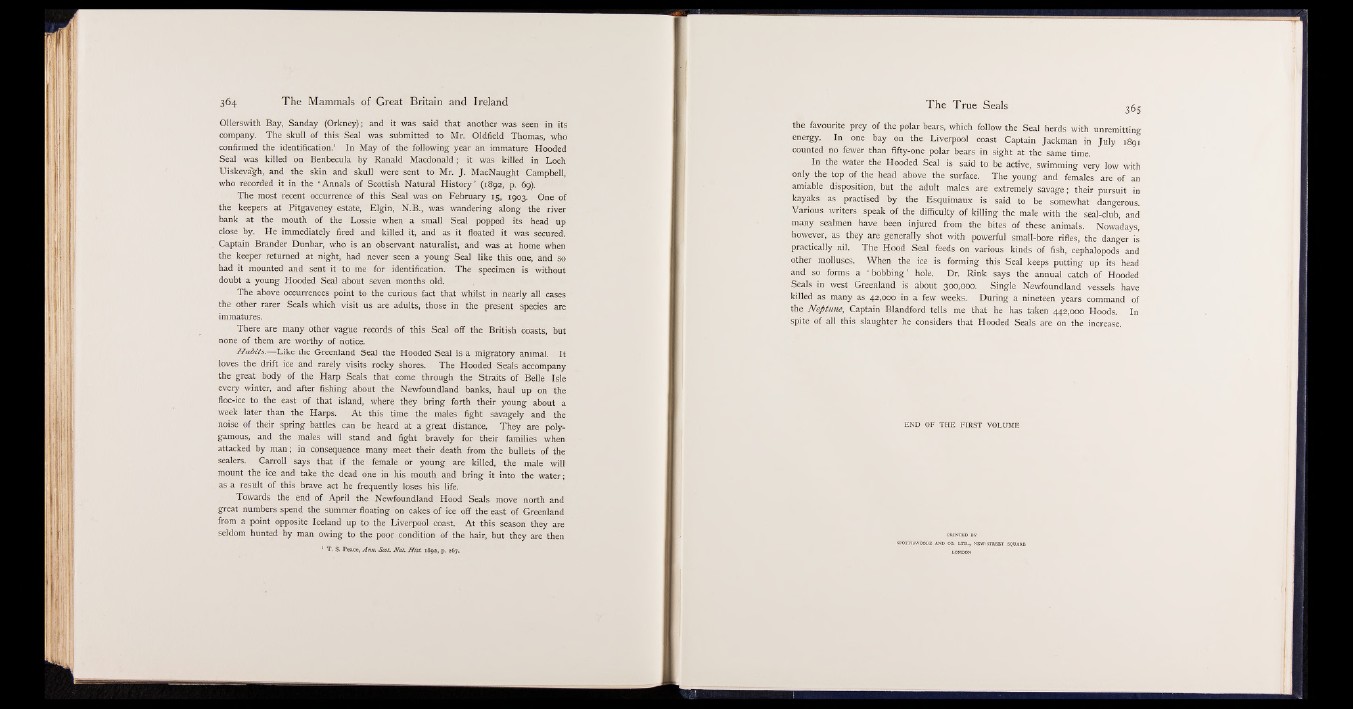
Ollerswith Bay, Sanday (Orkney); and it was said that another was seen in its
company. The skull of this Seal was submitted to Mr. Oldfield Thomas, who
confirmed the identification.1 In May of the following year an immature Hooded
Seal was killed on Benbecula by Ranald Macdonald; it was killed in Loch
Uiskevagh, and the skin and skull were sent to Mr. J. MacNaught Campbell,
who recorded it in the ‘ Annals of Scottish Natural History’ (1892, p. 69).
The most recent occurrence of this Seal was on February 15, 1903. One of
the keepers at Pitgaveney estate, Elgin, N.B., was wandering along the river
bank at the mouth of the Lossie when a small Seal popped its head up
close by. He immediately fired and killed it, and as it floated it was secured.
Captain Brander Dunbar, who is an observant naturalist, and was at home when
the keeper returned at night, had never seen a young Seal like this one, and so
had it mounted and sent it to me for identification. The specimen is without
doubt a young Hooded Seal about seven months old.
The above occurrences point to the curious fact that whilst in nearly all cases
the other rarer Seals which visit us are adults, those in the present species are
immatures.
There are many other vague records of this Seal off the British coasts, but
none of them are worthy of notice.
Habits.— Like the Greenland Seal the Hooded Seal is a migratory animal. It
loves the drift ice and rarely visits rocky shores. The Hooded Seals accompany
the great body of the Harp Seals that come through the Straits of Belle Isle
every winter, and after fishing about the Newfoundland banks, haul up on the
floe-ice to the east of that island, where they bring forth their young about a
week later than the Harps. At this time the males fight savagely and the
noise of their spring battles can be heard at a great distance. They are polygamous,
and the males will stand and fight bravely for their families when
attacked by man; in consequence many meet their death from the bullets of the
sealers. Carroll says that if the female or young are killed, the male will
mount the ice and take the dead one in his mouth and bring it into the water;
as a result of this brave act he frequently loses his life.
Towards the end of April the Newfoundland Hood Seals move north and
great numbers spend the summer floating on cakes of ice off the east of Greenland
from a point opposite Iceland up to the Liverpool coast. At this season they are
seldom hunted by man owing to the poor condition of the hair, but they are then
1 T. S. Peace, Ann. Scot. Nat. Hist. 1892, p. 267.
365
the favourite prey of the polar bears, which follow the Seal herds with unremitting
energy. In one bay on the Liverpool coast Captain Jackman in July 1891
counted no fewer than fifty-one polar bears in sight at the same time.
In the water the Hooded Seales said to be active, swimming very low with
only the top of the head above the surface. The young and females are of an
amiable disposition, but the adult males are extremely savage; their pursuit in
kayaks as practised by the Esquimaux is said to be somewhat dangerous.
Various writers speak of the difficulty of killing the male with the sea!-l|b, and
many sealmen have been injured from the bites of these animals. Nowadays,
however, as they are generally shot with powerful small-bore rifles, the danger is
practically nil. The Hood Seal feeds on various kinds1 of fish, cephalopods and
other molluscs. When the ice is forming this Seal keeps putting up its head
and ,'sp forms a ‘ bobbing’ hole. Dr. Rink says the annual catch of Hooded
Seals in west Greenland is about 300,000. Single Newfoundland vessels have
killed as many as 42,000 in a few weeks. During a nineteen years command of
the Neptune, Captain Blandford tells me that he has taken 442,000 Hoods. In
spite of all this slaughter he considers that Hooded Seals are on the increase.
END OF THE FIRST VOLUME
'-STREET SQUARE